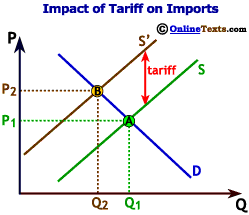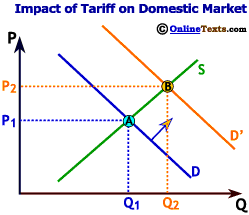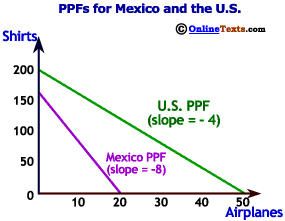
Chapter Nineteen: Lecture Notes -- International Trade
- Arguments for Protectionism
- Economic Theory of Protectionism: Tariffs & Quotas
- The Economic Argument for Free-Trade
- Protectionism Revisited
- NAFTA
The notion of free trade has been a controversial topic for centuries. At its core is a sense of nationalism, in that nations want to avoid being harmed by other nations. The problem is that trade issues are very complex and invariably certain people benefit at the expense of others. How do we make sense of this? First, we list common arguments for trade protection and examine how trade protection impacts markets. We then explore the economic theory of comparative advantage and see how trade impacts economic standards of living. After having learned the theory, we revisit and critically assess the arguments for protectionism. Finally, we discuss NAFTA and explore some of the controversies which surrounded that trade pact.
To keep things simple, we view everything from the U.S. point of view so that the U.S. economy is the "domestic" market.
- Saves American jobs: By raising the price of imports via tariffs or quotas, American industries are more competitive in the domestic market and, therefore, American workers' jobs will be spared and/or expanded.
- Protects infant industries: When industries are just beginning, it makes sense to protect them from the perils of foreign competition at first, until the industry grows and matures. At that time the protection can be lifted and the mature company will able to compete and survive. In other words, the entry costs are so high from foreign competition that trade barriers are necessary to overcome those barriers.
- Raises government revenue: Government revenues increase since the U.S. government collects the tariff revenue.
- Keeps firms in U.S.: This effect might occur for two reasons. First, firms will face less competition domestically and not feel the pressure to move to low-wage countries. Second, the firm who moves to another country must pay the higher import tax to sell the product in the U.S. and thus may not be as willing to relocate.
- Levels the playing field for those firms who adhere to stricter environmental and labor laws.: If firms in the U.S. must adhere to costly environmental regulation and give laborers certain rights and minimum working conditions, then U.S. firms are at a cost disadvantage compared with firms in nations that do not have to adhere to such regulations. Trade protection, therefore, makes the playing field a little more equal.
- National security: Certain products--defense secrets and computer technology, for example--are too technologically sensitive to export indiscriminately to nations that the domestic government does not wish to have access to that technology.
- Political tit for tat: If my trading partner plays unfairly, why should I play by the rules? The U.S. accuses Japan quite often of unfair trading practices, hence U.S. firms have a right to impose similar unfair trading practices to make trade more equal.
- Human rights violations: Trade policy may give the U.S. political leverage in coercing another country to improve its human rights violations (as the U.S. tried unsuccessfully with China).






